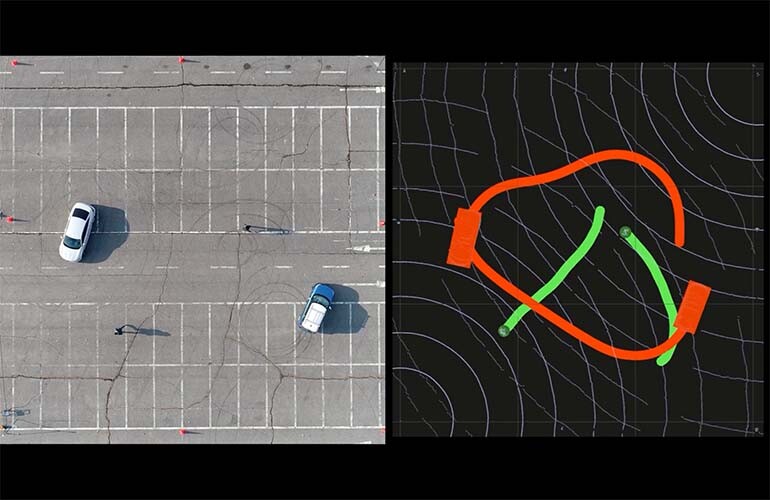While there has been a lot of press about autonomous vehicles, we are not quite to the self-driving future. There are 6 levels of autonomous driving as defined by the Society of Automotive Engineers (SAE), and level zero is where most cars currently fall. At level zero, a driver is needed for every aspect of driving. Level two is defined as “AI-assisted” driving, but the driver needs to maintain full awareness the entire time. All the alleged self-driving cars on the road are, at the highest, level 2 - the highest level that is legally allowed to be sold. Level 3 vehicles would cross the threshold of fully autonomous driving, with the max being level 5. Seoul Robotics hopes to reach Autonomous driving’s zenith by introducing a Level 5 Control Tower (LV5 CTRL TWR).
 Level 5 Control Tower is a system that replaces the need to install lidar software or hardware into individual vehicles by communicating with vehicles externally. The tower connects with software already onboard modern vehicles and utilizes their onboard Vehicle to Everything (V2X) communication capabilities. Leveraging the information the control tower gathers from lidar and 3D sensors installed within the infrastructure of a given space, commands can be sent to the vehicle. With the Level 5 Control Tower in place, it would no longer be necessary to install any extra hardware or software into a vehicle to achieve autonomy. According to HanBin Lee, CEO of Seoul Robotics, all that is needed for the vehicle to become driverless is to “simply have connectivity and automatic transmission.”
Level 5 Control Tower is a system that replaces the need to install lidar software or hardware into individual vehicles by communicating with vehicles externally. The tower connects with software already onboard modern vehicles and utilizes their onboard Vehicle to Everything (V2X) communication capabilities. Leveraging the information the control tower gathers from lidar and 3D sensors installed within the infrastructure of a given space, commands can be sent to the vehicle. With the Level 5 Control Tower in place, it would no longer be necessary to install any extra hardware or software into a vehicle to achieve autonomy. According to HanBin Lee, CEO of Seoul Robotics, all that is needed for the vehicle to become driverless is to “simply have connectivity and automatic transmission.”
Seoul Robotics is partnering with BMW to automate fleet logistics at their manufacturing facility in Munich with plans to expand to more of their facilities in Europe by the end of the year. This collaborative effort will also include BMW’s vehicle distribution centers. Essentially, the process of moving cars from the factory floor to their next location will be made seamless by implementation of Level 5 Control Tower and can save tens of millions of dollars in costs for Original Equipment Manufacturers (OEMS) like BMW when the last mile of last mile logistics can be automated.
Seoul Robotics may not have been the first player in autonomous driving, but the Level 5 Control Tower may solve a critical issue: the lack of GPS that current driverless technology encounters when entering factories and parking garages.
To use the system, lidar and 3D sensors are placed throughout the complex which are in constant communication with the Level 5 Control Tower, guiding vehicles safely to their destination in and out of the facility to their next stop. These sensors also eliminate blind spots and can enhance safety because all vehicles in a facility will be connected to the Level 5 Control Tower. Essentially, the system is “taking the idea of having the autonomous driving being done by the vehicle and you have the infrastructure driving them,” according to Lee. There is also no foreseeable limit to the number of vehicles that can be controlled by Level 5 Control Tower.
“This is one of a kind and has never been done before,” Lee states.
The tower itself is powered by Seoul Robotics own SENSR technology which can interact and is compatible with a large variety of lidar sensors by design. It’s important to Lee and the company that their technology is adaptable. Individual sensors and 3D cameras have their own strength or weaknesses, and this technological adaptability allows Seoul Robotics to utilize the most out of the technology available. Lee mentions that they wanted their tech to function in a similar vein to Microsoft’s operating system Windows with the hope that if, “SENSR was the Windows of lidar then Level 5 Control Tower is our first application, like a Microsoft Word.”
How far away are we from having our own self-driving vehicles? For now, Seoul robotics is focused on business-to-business over business-to-customer applications, though there are some potential applications that could see consumer use sooner. Apartment complexes could use this technology to automatically and efficiently park their resident’s vehicles. Airports and rental car agencies could benefit greatly as well by having automated reorganization of their parking areas.
Seoul Robotics plans to utilize the infrastructure around vehicles to fully realize autonomous driving. However, Lee does not see this technology necessarily allowing for autonomous driving on highways, but it could alleviate strain from driver shortages and could greatly help the trucking industry in the United States. Like the benefits this technology creates for last-mile logistics for OEMs, Lee is hopeful that, “we can automate the last mile of the trucking industry,” using the same technology. Lee also mentioned that Seoul Robotics “might be in US factories sooner than we expected,” but was not able to specify a timeframe.
Seoul Robotics is showcasing Level 5 Control Tower along with their entire SENSR portfolio at the Consumer Electronics Show (CES) at the Las Vegas Convention Center. They will have client partners at their booth #6559 for demonstrations.






